Qammer H. Abbasi
DRL-based Joint Resource Scheduling of eMBB and URLLC in O-RAN
Jul 16, 2024



Abstract:This work addresses resource allocation challenges in multi-cell wireless systems catering to enhanced Mobile Broadband (eMBB) and Ultra-Reliable Low Latency Communications (URLLC) users. We present a distributed learning framework tailored to O-RAN network architectures. Leveraging a Thompson sampling-based Deep Reinforcement Learning (DRL) algorithm, our approach provides real-time resource allocation decisions, aligning with evolving network structures. The proposed approach facilitates online decision-making for resource allocation by deploying trained execution agents at Near-Real Time Radio Access Network Intelligent Controllers (Near-RT RICs) located at network edges. Simulation results demonstrate the algorithm's effectiveness in meeting Quality of Service (QoS) requirements for both eMBB and URLLC users, offering insights into optimising resource utilisation in dynamic wireless environments.
Non-contact Lung Disease Classification via OFDM-based Passive 6G ISAC Sensing
May 15, 2024



Abstract:This paper is the first to present a novel, non-contact method that utilizes orthogonal frequency division multiplexing (OFDM) signals (of frequency 5.23 GHz, emitted by a software defined radio) to radio-expose the pulmonary patients in order to differentiate between five prevalent respiratory diseases, i.e., Asthma, Chronic obstructive pulmonary disease (COPD), Interstitial lung disease (ILD), Pneumonia (PN), and Tuberculosis (TB). The fact that each pulmonary disease leads to a distinct breathing pattern, and thus modulates the OFDM signal in a different way, motivates us to acquire OFDM-Breathe dataset, first of its kind. It consists of 13,920 seconds of raw RF data (at 64 distinct OFDM frequencies) that we have acquired from a total of 116 subjects in a hospital setting (25 healthy control subjects, and 91 pulmonary patients). Among the 91 patients, 25 have Asthma, 25 have COPD, 25 have TB, 5 have ILD, and 11 have PN. We implement a number of machine and deep learning models in order to do lung disease classification using OFDM-Breathe dataset. The vanilla convolutional neural network outperforms all the models with an accuracy of 97%, and stands out in terms of precision, recall, and F1-score. The ablation study reveals that it is sufficient to radio-observe the human chest on seven different microwave frequencies only, in order to make a reliable diagnosis (with 96% accuracy) of the underlying lung disease. This corresponds to a sensing overhead that is merely 10.93% of the allocated bandwidth. This points to the feasibility of 6G integrated sensing and communication (ISAC) systems of future where 89.07% of bandwidth still remains available for information exchange amidst on-demand health sensing. Through 6G ISAC, this work provides a tool for mass screening for respiratory diseases (e.g., COVID-19) at public places.
Cuff-less Arterial Blood Pressure Waveform Synthesis from Single-site PPG using Transformer & Frequency-domain Learning
Jan 09, 2024



Abstract:We propose two novel purpose-built deep learning (DL) models for synthesis of the arterial blood pressure (ABP) waveform in a cuff-less manner, using a single-site photoplethysmography (PPG) signal. We utilize the public UCI dataset on cuff-less blood pressure (CLBP) estimation to train and evaluate our DL models. Firstly, we implement a transformer model that incorporates positional encoding, multi-head attention, layer normalization, and dropout techniques, and synthesizes the ABP waveform with a mean absolute error (MAE) of 14. Secondly, we implement a frequency-domain (FD) learning approach where we first obtain the discrete cosine transform (DCT) coefficients of the PPG and ABP signals corresponding to two cardiac cycles, and then learn a linear/non-linear (L/NL) regression between them. We learn that the FD L/NL regression model outperforms the transformer model by achieving an MAE of 11.87 and 8.01, for diastolic blood pressure (DBP) and systolic blood pressure (SBP), respectively. Our FD L/NL regression model also fulfills the AAMI criterion of utilizing data from more than 85 subjects, and achieves grade B by the BHS criterion.
A low-cost PPG sensor-based empirical study on healthy aging based on changes in PPG morphology
Dec 20, 2023Abstract:We present the findings of an experimental study whereby we correlate the changes in the morphology of the photoplethysmography (PPG) signal to healthy aging. Under this pretext, we estimate the biological age of a person as well as the age group he/she belongs to, using the PPG data that we collect via a non-invasive low-cost MAX30102 PPG sensor. Specifically, we collect raw infrared PPG data from the finger-tip of 179 apparently healthy subjects, aged 3-65 years. In addition, we record the following metadata of each subject: age, gender, height, weight, family history of cardiac disease, smoking history, vitals (heart rate and SpO2). We pre-process the raw PPG data to remove noise, artifacts, and baseline wander. We then construct 60 features based upon the first four PPG derivatives, the so-called VPG, APG, JPG, and SPG signals, and the demographic features. We then do correlation-based feature-ranking (which retains 26 most important features), followed by Gaussian noise-based data augmentation (which results in 15-fold increase in the size of our dataset). Finally, we feed the feature set to three machine learning classifiers (logistic regression, decision tree, random forest), and two shallow neural networks: a feedforward neural network (FFNN) and a convolutional neural network (CNN). For the age group classification, the shallow FFNN performs the best with 98% accuracy for binary classification (3-15 years vs. 15+ years), and 97% accuracy for three-class classification (3-12 years, 13-30 years, 30+ years). For biological age prediction, the shallow FFNN again performs the best with a mean absolute error (MAE) of 1.64.
Pathloss-based non-Line-of-Sight Identification in an Indoor Environment: An Experimental Study
Jul 29, 2023

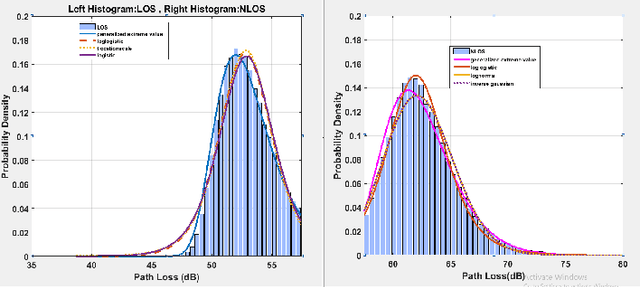
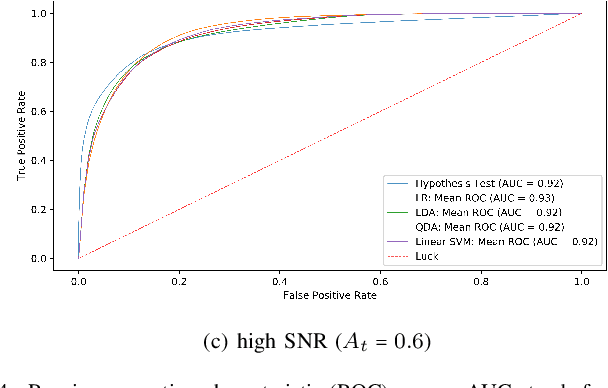
Abstract:This paper reports the findings of an experimental study on the problem of line-of-sight (LOS)/non-line-of-sight (NLOS) classification in an indoor environment. Specifically, we deploy a pair of NI 2901 USRP software-defined radios (SDR) in a large hall. The transmit SDR emits an unmodulated tone of frequency 10 KHz, on a center frequency of 2.4 GHz, using three different signal-to-noise ratios (SNR). The receive SDR constructs a dataset of pathloss measurements from the received signal as it moves across 15 equi-spaced positions on a 1D grid (for both LOS and NLOS scenarios). We utilize our custom dataset to estimate the pathloss parameters (i.e., pathloss exponent) using the least-squares method, and later, utilize the parameterized pathloss model to construct a binary hypothesis test for NLOS identification. Further, noting that the pathloss measurements slightly deviate from Gaussian distribution, we feed our custom dataset to four machine learning (ML) algorithms, i.e., linear support vector machine (SVM) and radial basis function SVM (RBF-SVM), linear discriminant analysis (LDA), quadratic discriminant analysis (QDA), and logistic regression (LR). It turns out that the performance of the ML algorithms is only slightly superior to the Neyman-Pearson-based binary hypothesis test (BHT). That is, the RBF-SVM classifier (the best performing ML classifier) and the BHT achieve a maximum accuracy of 88.24% and 87.46% for low SNR, 83.91% and 81.21% for medium SNR, and 87.38% and 86.65% for high SNR.
Non-Contact Monitoring of Dehydration using RF Data Collected off the Chest and the Hand
Jun 16, 2023



Abstract:We report a novel non-contact method for dehydration monitoring. We utilize a transmit software defined radio (SDR) that impinges a wideband radio frequency (RF) signal (of frequency 5.23 GHz) onto either the chest or the hand of a subject who sits nearby. Further, another SDR in the closed vicinity collects the RF signals reflected off the chest (or passed through the hand) of the subject. Note that the two SDRs exchange orthogonal frequency division multiplexing (OFDM) signal, whose individual subcarriers get modulated once it reflects off (passes through) the chest (the hand) of the subject. This way, the signal collected by the receive SDR consists of channel frequency response (CFR) that captures the variation in the blood osmolality due to dehydration. The received raw CFR data is then passed through a handful of machine learning (ML) classifiers which once trained, output the classification result (i.e., whether a subject is hydrated or dehydrated). For the purpose of training our ML classifiers, we have constructed our custom HCDDM-RF-5 dataset by collecting data from 5 Muslim subjects (before and after sunset) who were fasting during the month of Ramadan. Specifically, we have implemented and tested the following ML classifiers (and their variants): K-nearest neighbour (KNN), support vector machine (SVM), decision tree (DT), ensemble classifier, and neural network classifier. Among all the classifiers, the neural network classifier acheived the best classification accuracy, i.e., an accuracy of 93.8% for the proposed CBDM method, and an accuracy of 96.15% for the proposed HBDM method. Compared to prior work where the reported accuracy is 97.83%, our proposed non-contact method is slightly inferior (as we report a maximum accuracy of 96.15%); nevertheless, the advantages of our non-contact dehydration method speak for themselves.
Contactless Human Activity Recognition using Deep Learning with Flexible and Scalable Software Define Radio
Apr 18, 2023Abstract:Ambient computing is gaining popularity as a major technological advancement for the future. The modern era has witnessed a surge in the advancement in healthcare systems, with viable radio frequency solutions proposed for remote and unobtrusive human activity recognition (HAR). Specifically, this study investigates the use of Wi-Fi channel state information (CSI) as a novel method of ambient sensing that can be employed as a contactless means of recognizing human activity in indoor environments. These methods avoid additional costly hardware required for vision-based systems, which are privacy-intrusive, by (re)using Wi-Fi CSI for various safety and security applications. During an experiment utilizing universal software-defined radio (USRP) to collect CSI samples, it was observed that a subject engaged in six distinct activities, which included no activity, standing, sitting, and leaning forward, across different areas of the room. Additionally, more CSI samples were collected when the subject walked in two different directions. This study presents a Wi-Fi CSI-based HAR system that assesses and contrasts deep learning approaches, namely convolutional neural network (CNN), long short-term memory (LSTM), and hybrid (LSTM+CNN), employed for accurate activity recognition. The experimental results indicate that LSTM surpasses current models and achieves an average accuracy of 95.3% in multi-activity classification when compared to CNN and hybrid techniques. In the future, research needs to study the significance of resilience in diverse and dynamic environments to identify the activity of multiple users.
Reconfigurable Intelligent Surface-Assisted Cross-Layer Authentication for Secure and Efficient Vehicular Communications
Mar 15, 2023



Abstract:Intelligent transportation systems increasingly depend on wireless communication, facilitating real-time vehicular communication. In this context, message authentication is crucial for establishing secure and reliable communication. However, security solutions must consider the dynamic nature of vehicular communication links, which fluctuate between line-of-sight (LoS) and non-line-of-sight (NLoS). In this paper, we propose a lightweight cross-layer authentication scheme that employs public-key infrastructure-based authentication for initial legitimacy detection while using keyed-based physical-layer re-authentication for message verification. However, the latter's detection probability (P_d) decreases with the reduction of the signal-to-noise ratio (SNR). Therefore, we examine using Reconfigurable Intelligent Surface (RIS) to enhance the SNR value directed toward the designated vehicle and consequently improve the P_d, especially for NLoS scenarios. We conducted theoretical analysis and practical implementation of the proposed scheme using a 1-bit RIS, consisting of 64 x 64 reflective units. Experimental results show a significant improvement in the P_d, increasing from 0.82 to 0.96 at SNR = - 6 dB for an orthogonal frequency division multiplexing system with 128 subcarriers. We also conducted informal and formal security analyses, using Burrows-Abadi-Needham (BAN)-logic, to prove the scheme's ability to resist passive and active attacks. Finally, the computation and communication comparisons demonstrate the superior performance of the proposed scheme compared to traditional crypto-based methods.
A large-scale multimodal dataset of human speech recognition
Mar 15, 2023Abstract:Nowadays, non-privacy small-scale motion detection has attracted an increasing amount of research in remote sensing in speech recognition. These new modalities are employed to enhance and restore speech information from speakers of multiple types of data. In this paper, we propose a dataset contains 7.5 GHz Channel Impulse Response (CIR) data from ultra-wideband (UWB) radars, 77-GHz frequency modulated continuous wave (FMCW) data from millimetre wave (mmWave) radar, and laser data. Meanwhile, a depth camera is adopted to record the landmarks of the subject's lip and voice. Approximately 400 minutes of annotated speech profiles are provided, which are collected from 20 participants speaking 5 vowels, 15 words and 16 sentences. The dataset has been validated and has potential for the research of lip reading and multimodal speech recognition.
Towards a Sustainable Internet-of-Underwater-Things based on AUVs, SWIPT, and Reinforcement Learning
Feb 21, 2023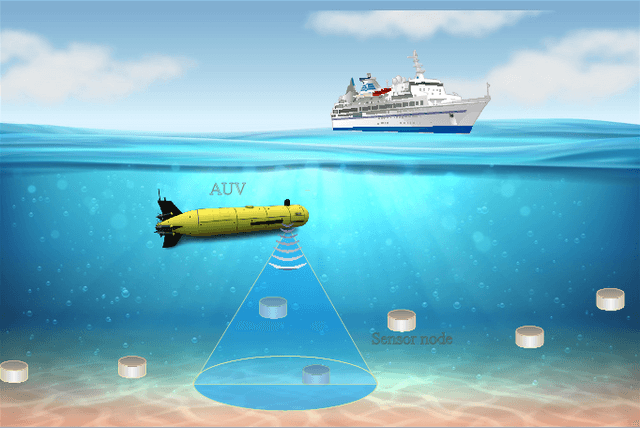
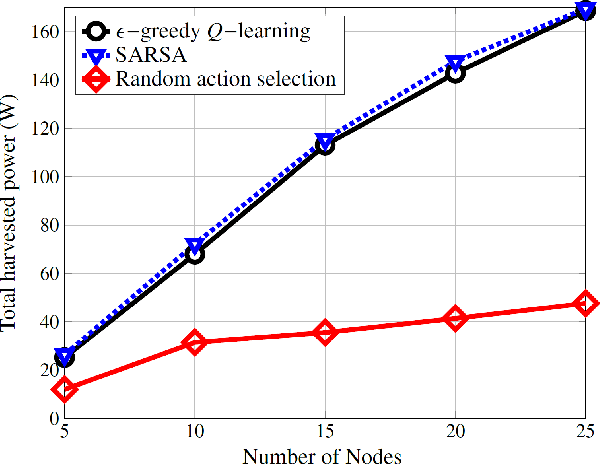
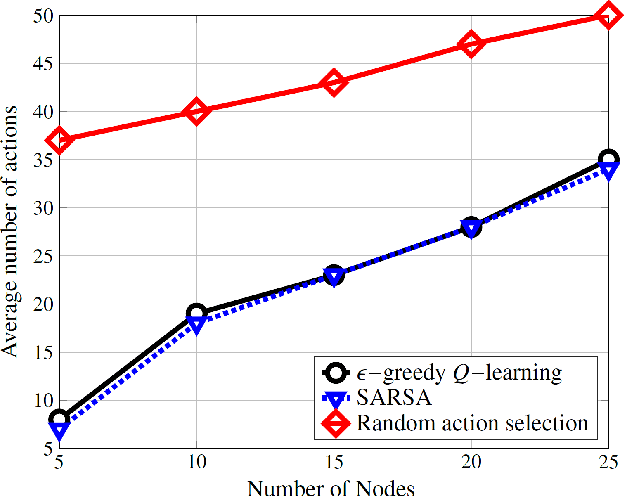
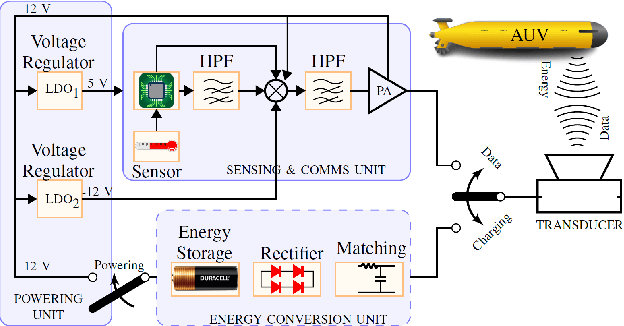
Abstract:Life on earth depends on healthy oceans, which supply a large percentage of the planet's oxygen, food, and energy. However, the oceans are under threat from climate change, which is devastating the marine ecosystem and the economic and social systems that depend on it. The Internet-of-underwater-things (IoUTs), a global interconnection of underwater objects, enables round-the-clock monitoring of the oceans. It provides high-resolution data for training machine learning (ML) algorithms for rapidly evaluating potential climate change solutions and speeding up decision-making. The sensors in conventional IoUTs are battery-powered, which limits their lifetime, and constitutes environmental hazards when they die. In this paper, we propose a sustainable scheme to improve the throughput and lifetime of underwater networks, enabling them to potentially operate indefinitely. The scheme is based on simultaneous wireless information and power transfer (SWIPT) from an autonomous underwater vehicle (AUV) used for data collection. We model the problem of jointly maximising throughput and harvested power as a Markov Decision Process (MDP), and develop a model-free reinforcement learning (RL) algorithm as a solution. The model's reward function incentivises the AUV to find optimal trajectories that maximise throughput and power transfer to the underwater nodes while minimising energy consumption. To the best of our knowledge, this is the first attempt at using RL to ensure sustainable underwater networks via SWIPT. The scheme is implemented in an open 3D RL environment specifically developed in MATLAB for this study. The performance results show up 207% improvement in energy efficiency compared to those of a random trajectory scheme used as a baseline model.
 Add to Chrome
Add to Chrome Add to Firefox
Add to Firefox Add to Edge
Add to Edge